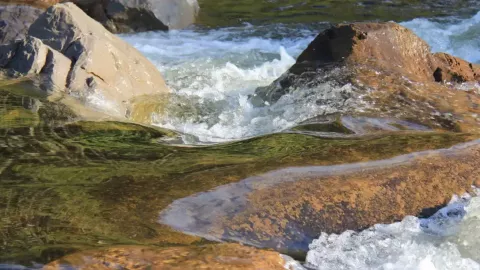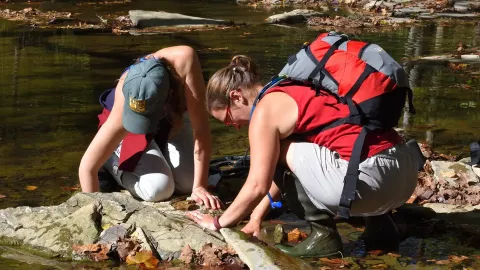Forest Hydrology and Watershed Management
Forest Hydrology and Watershed Management
Best Practices for Managing Water Resources in Appalachia

A McIntire-Stennis supported project
The extraction of coal, gas, and timber has been the primary economic driver for the Appalachian region for more than a century. Although these activities provide jobs and revenue, the on-going degradation of water quality and aquatic habitat as well as compromised water supplies from resource extraction have been clearly documented. The potential consequences from global climate change along with disturbances from resource extraction result in a high degree of uncertainty for the region’s water resources. Management solutions developed to protect water resources from these issues has been a focus of major research in the University of Kentucky’s Department of Forestry and Natural Resources.
McIntire-Stennis supported research aims not only to develop best management practices (BMPs) for protecting watersheds from resource extraction, but research has also developed and demonstrated practices for restoring watershed health in historically impacted systems. Research in this area has informed policy development, provided professional and traditional outdoor teaching laboratories, and contributed to the protection and restoration of thousands of acres of Appalachian forests and their water resources.
Collaboration
Researchers at the University of Kentucky are working in partnership with the USDA Forest Service, US Geological Survey, US Department of Interior’s Office of Surface Mining Reclamation and Enforcement, USDA Natural Resources Conservation Service, Appalachian Regional Commission, Kentucky Department of Fish and Wildlife Resources, Kentucky Division of Forestry, Kentucky Department of Natural Resources, National Fish and Wildlife Foundation, Arbor Day Foundation, Sierra Club, and numerous regional conservation organizations.
Impact
In Kentucky, information from this research has been used to revise state mandated timber harvesting BMPs used to protect water quality. Over five PhD degrees, 26 MS degrees, hundreds of undergraduate students, and more than 20,000 volunteers have been engaged in this research.
125 million
trees have been planted in Appalachia to restore surface coal mining sites using new BMPs derived from this research.
3,319 streams
annually afforded protection using BMPs directly informed by this research.
$4.9 billion
of annual economic contribution is generated from the 215,000 acres of private forest land harvested using the required BMPs derived from this research.
Conservation and Management of Aquatic and Riparian Wildlife
A McIntire-Stennis supported project
The occurrence and health of aquatic animals and those living in close proximity to water, known as riparian species, act as barometers of the impacts of land use on ecosystems. In some instances, these species become threatened or endangered due to negative impacts associated with land use. Understanding threats to aquatic and riparian biodiversity, quantifying how populations respond to these threats, and developing conservation and/or management strategies to bolster populations is a focus of work at the Department of Forestry and Natural Resources at the University of Kentucky. Specifically, our McIntire-Stennis supported research has examined the response of salamanders to land-use reclamation, quantified the impacts of emerging infectious disease on snake populations, examined the causes of unknown declines in freshwater mussels, and evaluated the effectiveness of wetland restoration on imperiled amphibians.
Results from this research assist with the development of management tools and provide decision support for natural resource managers. Additionally, the project provides educational and research opportunities for undergraduate and graduate students as well as the general public.
Collaboration
This research requires a broad range of partners including the USDA Forest Service, US Fish and Wildlife Service, US Geological Survey National Wildlife Health Center, University of Kentucky Center for Applied Energy Research, Kentucky Department of Fish and Wildlife Resources, and Smithsonian Institution.
Impact
This emerging research on aquatic and riparian species is providing critical information to inform practices to allow for sustainable use of forest resources.

28 students & 32 publications
that in the last 5 years have been developed to directly aid in the management of our forests and rural landscapes.
$740,000
of competitive research funds have been secured to address critical species work.
3,500
K-12 students educated in the last 5 years in Kentucky.
About McIntire-Stennis
The McIntire-Stennis program, a unique federal-state partnership, cultivates and delivers forestry and natural resource innovations for a better future. By advancing research and education that increases the understanding of emerging challenges and fosters the development of relevant solutions, the McIntire-Stennis program has ensured healthy resilient forests and communities and an exceptional natural resources workforce since 1962.
Associated Faculty
Research Topic Areas
Research Quick Links
Forestry and Natural Resources Department
forestry.department@uky.edu
(859) 257-7596
Forestry and Natural Resources Extension
forestry.extension@uky.edu
(859) 257-7597
